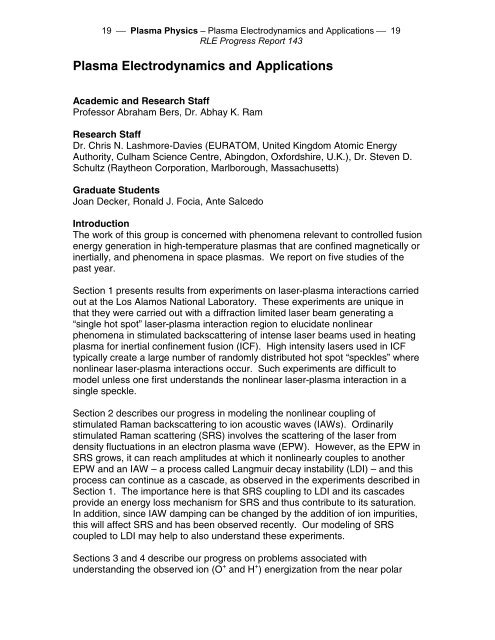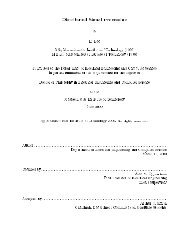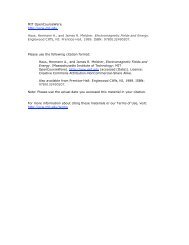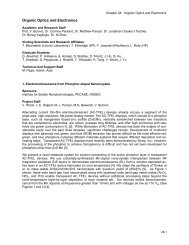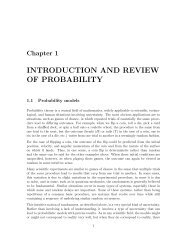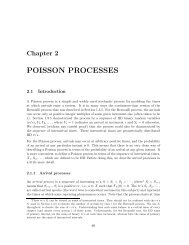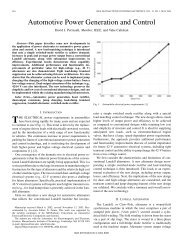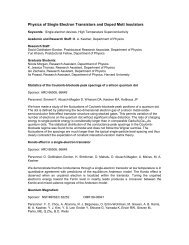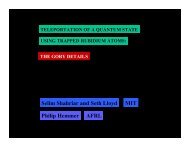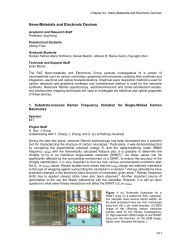RLE Progress Report No - Research Laboratory of Electronics - MIT
RLE Progress Report No - Research Laboratory of Electronics - MIT
RLE Progress Report No - Research Laboratory of Electronics - MIT
You also want an ePaper? Increase the reach of your titles
YUMPU automatically turns print PDFs into web optimized ePapers that Google loves.
Plasma Electrodynamics and Applications<br />
Academic and <strong>Research</strong> Staff<br />
Pr<strong>of</strong>essor Abraham Bers, Dr. Abhay K. Ram<br />
<strong>Research</strong> Staff<br />
Dr. Chris N. Lashmore-Davies (EURATOM, United Kingdom Atomic Energy<br />
Authority, Culham Science Centre, Abingdon, Oxfordshire, U.K.), Dr. Steven D.<br />
Schultz (Raytheon Corporation, Marlborough, Massachusetts)<br />
Graduate Students<br />
Joan Decker, Ronald J. Focia, Ante Salcedo<br />
Introduction<br />
The work <strong>of</strong> this group is concerned with phenomena relevant to controlled fusion<br />
energy generation in high-temperature plasmas that are confined magnetically or<br />
inertially, and phenomena in space plasmas. We report on five studies <strong>of</strong> the<br />
past year.<br />
Section 1 presents results from experiments on laser-plasma interactions carried<br />
out at the Los Alamos National <strong>Laboratory</strong>. These experiments are unique in<br />
that they were carried out with a diffraction limited laser beam generating a<br />
“single hot spot” laser-plasma interaction region to elucidate nonlinear<br />
phenomena in stimulated backscattering <strong>of</strong> intense laser beams used in heating<br />
plasma for inertial confinement fusion (ICF). High intensity lasers used in ICF<br />
typically create a large number <strong>of</strong> randomly distributed hot spot “speckles” where<br />
nonlinear laser-plasma interactions occur. Such experiments are difficult to<br />
model unless one first understands the nonlinear laser-plasma interaction in a<br />
single speckle.<br />
Section 2 describes our progress in modeling the nonlinear coupling <strong>of</strong><br />
stimulated Raman backscattering to ion acoustic waves (IAWs). Ordinarily<br />
stimulated Raman scattering (SRS) involves the scattering <strong>of</strong> the laser from<br />
density fluctuations in an electron plasma wave (EPW). However, as the EPW in<br />
SRS grows, it can reach amplitudes at which it nonlinearly couples to another<br />
EPW and an IAW – a process called Langmuir decay instability (LDI) – and this<br />
process can continue as a cascade, as observed in the experiments described in<br />
Section 1. The importance here is that SRS coupling to LDI and its cascades<br />
provide an energy loss mechanism for SRS and thus contribute to its saturation.<br />
In addition, since IAW damping can be changed by the addition <strong>of</strong> ion impurities,<br />
this will affect SRS and has been observed recently. Our modeling <strong>of</strong> SRS<br />
coupled to LDI may help to also understand these experiments.<br />
Sections 3 and 4 describe our progress on problems associated with<br />
understanding the observed ion (O + and H + ) energization from the near polar
egions <strong>of</strong> the ionosphere to the magnetosphere. One particular problem relates<br />
to understanding the nature <strong>of</strong> the radio frequency (RF) lower-hybrid fields that<br />
exist in density depleted regions across the geomagnetic field B 0<br />
. These regions<br />
are <strong>of</strong> the order <strong>of</strong> tens to 10 2 m across B <br />
0<br />
and extend (approximately in a<br />
homogeneous manner) to maybe 10 5 m along B 0<br />
. The RF fields in these regions<br />
have been measured (by satellites and rockets) across B <br />
0<br />
along B <br />
0<br />
at various altitudes<br />
and are essentially similar. How these fields are excited remains an<br />
unresolved problem. Two possibilities exist: electrons (from substorm events)<br />
streaming down along B 0<br />
, inside the density depleted region, excite the<br />
anomalous Doppler instability which generates the observed quasi-electrostatic<br />
fields; or ambient noise (auroral “hiss”), which exists all along B <br />
0<br />
and outside the<br />
density depleted regions, excites the observed fields inside the cavity formed by<br />
the density depleted region. Each <strong>of</strong> these excitation mechanisms needs to be<br />
explored in detail to see which one (if any) is consistent with observations. In the<br />
past year, we have continued to address the problem <strong>of</strong> wave modes in density<br />
depleted regions which is relevant to understanding the nature <strong>of</strong> the observed<br />
fields, irrespective <strong>of</strong> both their excitation mechanism and their action in<br />
energizing ions. We report on both a simplified mode analysis and variational<br />
principle for such models.<br />
Section 5 describes progress in our continuing effort to examine the use <strong>of</strong><br />
electron Bernstein waves (EBWs) for plasma heating and current drive in highbeta,<br />
near-unity aspect ratio (“spherical”) tokamaks, such as in the National<br />
Spherical Tokamak Experiment (NSTX). The importance <strong>of</strong> EBWs is that, in the<br />
electron-cyclotron range <strong>of</strong> frequencies, they are the only type <strong>of</strong> wave with direct<br />
access to depositing energy and momentum on electrons in the center <strong>of</strong> such<br />
plasmas. Here we report on our analysis <strong>of</strong> emission from EBWs in the plasma<br />
and how this relates to the excitation <strong>of</strong> EBWs from outside the plasma.<br />
Subject Index Keywords<br />
Magnetic confinement fusion (MFE); National Spherical Tokamak Experiment<br />
(NSTX); inertial confinement fusion (ICF); laser-plasma interactions; space<br />
plasmas; ionosphere; magnetosphere; stimulated Raman scattering (SRS);<br />
Langmuir decay instability (LDI); LDI cascade; electron plasma wave (EPW); ion<br />
acoustic wave (IAW); electron Bernstein wave (EBW); lower hybrid; resonant<br />
absorption modes; variational principle; mode conversion; emission.
1. Results <strong>of</strong> Recent Single Hot Spot Laser-Plasma Experiments at Los Alamos<br />
National <strong>Laboratory</strong><br />
Sponsors:<br />
Los Alamos National <strong>Laboratory</strong> (LANL) Contract E29060017-8F<br />
Project Staff:<br />
R. J. Focia, A. Bers, and A. K. Ram<br />
We report on the results <strong>of</strong> recent experiments performed by R. J. Focia in collaboration with D.<br />
S. Montgomery <strong>of</strong> the Los Alamos National <strong>Laboratory</strong> (LANL). The experiments were the sixth<br />
in a series designed to characterize the fundamental interaction <strong>of</strong> a single laser hot spot, or<br />
speckle, with a preformed laser-produced plasma. The results reported here are on the<br />
measurement <strong>of</strong> electron plasma waves driven by stimulated Raman scattering using collective<br />
Thomson scattering. Multiple waves were observed whose frequency and wave vector spacing is<br />
consistent with cascade steps from the Langmuir decay instability.<br />
The EPW amplitude can be large for moderate SRS reflectivity so that saturation by nonlinear<br />
mechanisms is expected. One such mechanism is the Langmuir decay instability (LDI), where<br />
the daughter Langmuir wave from SRS decays into a secondary Langmuir wave and an ion<br />
acoustic wave (IAW). LDI occurs when the amplitude <strong>of</strong> the primary EPW exceeds a threshold<br />
that is proportional to the damping rates for the secondary EPW and IAW. The growth rate for<br />
LDI is maximized when the daughter EPW and IAW are propagating antiparallel and parallel,<br />
respectively, to the primary Langmuir wave. Subsequent Langmuir wave decays due to LDI are<br />
possible if their amplitudes exceed the threshold. We use the terminology that an EPW<br />
generated by LDI is called an LDI cascade step and collectively more than one cascade step is<br />
called LDI cascade. The LDI cascade can saturate SRS since wave energy from the SRS EPW<br />
couples into secondary EPWs that are non-resonant with the SRS process. Observation <strong>of</strong> LDI<br />
driven IAWs correlated with SRS have been reported recently. 1<br />
However, due to plasma<br />
inhomogeneity, it could not be shown whether strong turbulence or weak LDI cascade was<br />
observed in those experiments. 2<br />
We present observations <strong>of</strong> multiple LDI cascade steps driven by SRS backscatter. The<br />
experiments are performed using a single hot spot (SHS) produced by a laser to drive SRS in a<br />
plasma. 3,4 The SHS laser focal spot is characterized by a speckle width <strong>of</strong> Fλ 0<br />
≈2.5±0.15 µm and<br />
speckle length <strong>of</strong> 7F 2 λ 0<br />
≈75µm, where λ 0<br />
is the laser wavelength (527 nm for the SHS interaction<br />
laser) and F is the focal ratio. The plasma initial conditions are homogeneous on the scale <strong>of</strong> the<br />
laser focal spot volume where the interaction occurs. The EPW spectrum from SRS and LDI is<br />
measured using collective Thomson scattering, and structure is observed in the spectra<br />
consistent with LDI cascade. Up to two LDI cascade steps are inferred from the measurements<br />
presented here.<br />
The experiment was conducted at the Los Alamos National <strong>Laboratory</strong> (LANL) using the<br />
TRIDENT laser facility. 3<br />
The plasma and laser conditions for single hot spot experiments have<br />
been characterized elsewhere. 4<br />
A schematic <strong>of</strong> the experimental setup is shown in Figure 1. The<br />
plasma is formed by vaporizing a thin foil target by heating it with a line-focused λ=527 nm laser<br />
1 S. Depierreux, J. Fuchs, C. Labaune, A. Michard, H. A. Baldis, D. Pesme, S. Hüller, and G. Laval, “First Observation <strong>of</strong><br />
Ion Acoustic Waves Produces by the Langmuir Decay Instability,” Phys. Rev. Lett. 84(13): 2869-2872 (2000).<br />
2 D. S. Montgomery, “Comment on First Observation <strong>of</strong> Ion Acoustic Waves Produced by the Langmuir Decay Instability,”<br />
Phys. Rev. Lett. 86(16): 3686 (2000), and D. Pesme et al., Phys. Rev. Lett. 86(16): 3686 (2000).<br />
3 N. K. Moncur. R. P. Johnson, R. G. Watt, and R. B. Gibson, “Trident: A versatile high-power Nd:glass laser facility for<br />
inertial confinement fusion experiments,” App. Opt. 34(21): 4274-4283 (1995).<br />
4 D. S. Montgomery, R. P. Johnson, J. A. Cobble, J. C. Fernández, “Characterization <strong>of</strong> plasma and laser conditions for<br />
single hot spot experiments,” Laser and Particle Beams 17(3): 349-359 (1999).
eam. This heater beam is defocused so as to create a plasma with density scale lengths<br />
transverse and parallel to the interaction laser focal spot <strong>of</strong> ~200 µm and ~1000 µm, respectively.<br />
Thus, the plasma is considered quasi-homogeneous over the interaction volume <strong>of</strong> the SHS. The<br />
targets used were ~1 mm in diameter and ~6.5 µm thick. The bulk <strong>of</strong> the data was collected on<br />
parylene (C 8<br />
H 8<br />
) targets. However, the behavior <strong>of</strong> other materials was also investigated in the<br />
experiment. The heater beam has a flat-topped pulse pr<strong>of</strong>ile with duration <strong>of</strong> 1.2 ns full-width at<br />
half maximum (FWHM). At a time 200 ps after the heater beam is turned <strong>of</strong>f the interaction beam<br />
(λ=527 nm), having a Gaussian pulse width <strong>of</strong> 200±10 ps FWHM, is focused into the plasma<br />
Figure 1: Schematic diagram <strong>of</strong> the single hot spot experiment.<br />
perpendicular to the plasma flow (i.e. parallel to the original surface <strong>of</strong> the target) through an f/4.4<br />
lens. The ultraviolet (λ=351 nm) Thomson probe beam is also a Gaussian pulse with a 200±10
ps FWHM, coincident in time with the interaction beam, and is focused into the plasma through<br />
an f/4.5 lens. The Thomson scattered light is collected through the full aperture <strong>of</strong> the collection<br />
optic (f/4). The Thomson scattering diagnostic was set up to look only at the forward propagating<br />
EPWs, i.e. those propagating in the same direction as the interaction laser. Although we do not<br />
image the backward propagating EPWs their presence is inferred from the resultant Thomson<br />
spectrum.<br />
Thomson scattering is a resonant process that requires frequency, ω and wave vector, k <br />
matching be satisfied. 5<br />
Frequency and wave vector matching cannot be achieved with arbitrary<br />
probe and collection angles. To calculate the resonance points and thus the probe and collection<br />
angles required we use the usual dispersion relation for an EM wave in a plasma and kinetic<br />
dispersion relations for EPWs and IAWs. The focal ratio <strong>of</strong> the probe and collection optics allows<br />
for a finite range <strong>of</strong> wave vectors (and frequencies for the scattered light) to participate in the<br />
Thomson scattering. The Thomson probe was set up to investigate plasma densities near<br />
n e<br />
/n c<br />
~0.03, where n c<br />
is the critical density. The probe beam was sent in at 50±6.3 degrees and<br />
the scattered light was collected at 63±7.1 degrees, which allowed probing waves parallel to k o<br />
(the SHS beam) from 1.34k o<br />
to 1.76k o<br />
. We calculate that our diagnostic would allow resolution <strong>of</strong><br />
the SRS EPW and up to three subsequent forward propagating LDI cascade steps. Half <strong>of</strong> the<br />
Thomson scattered light was sent to a diagnostic that resolved the wavelength in time and the<br />
other half was sent to a diagnostic that resolved the wavelength versus angle on the collection<br />
optic (i.e. effectively ω vs. k ) integrated over the duration <strong>of</strong> the probe pulse. The latter was<br />
accomplished by imaging the optic plane <strong>of</strong> the collection lens, rather than its focal plane. 6<br />
diagnostic was useful in understanding any structure observed in the time-resolved spectra.<br />
The backscattered SRS spectrum from a particular shot in a regime where LDI is observed is<br />
shown in Figure 2. <strong>No</strong>te that in all spectral images presented here, the wavelength is the<br />
spectrally resolved wavelength <strong>of</strong> the measured light and is related to the radial frequency <strong>of</strong> the<br />
wave by λ = 2πc/ω, where c is the speed <strong>of</strong> light. For this shot the intensity was I≈1.92x10 15<br />
W/cm 2<br />
and the measured SRS reflectivity was R≈3.2%. Thomson scattering <strong>of</strong>f <strong>of</strong> ion acoustic<br />
waves from similar shots indicated an electron temperature <strong>of</strong> T e<br />
≈350±50 eV. The SRS spectrum<br />
has an average center wavelength <strong>of</strong> ~657.4 nm and duration <strong>of</strong> ~154 ps. As a consistency<br />
check, from the SRS data we estimate that the density fluctuation for this shot<br />
2 2 1/ 2<br />
δ =0.0284 exceeds the LDI threshold <strong>of</strong><br />
( n / n)<br />
= [4R<br />
∆k<br />
n n k L<br />
max<br />
/( /<br />
co)<br />
o<br />
]<br />
1/ 2<br />
1/ 2<br />
( δ n / n)<br />
= 4kLλD<br />
( via<br />
/ ωia<br />
) ( vL<br />
/ ω<br />
p<br />
) =0.0117. 7,8 In these equations R max<br />
is the maximum<br />
reflectivity, ∆k is the spectral width <strong>of</strong> the SRS, n is the electron density, k o<br />
and n co<br />
are the wave<br />
number and critical density <strong>of</strong> the incident beam, L is the interaction length, k L<br />
is the wave vector<br />
<strong>of</strong> the SRS generated Langmuir wave, λ D<br />
is the electron Debye length, (ν ia<br />
/ω ia<br />
) is the ratio <strong>of</strong> the<br />
IAW damping to its real frequency, and (ν L<br />
/ω p<br />
) is the ratio <strong>of</strong> the Langmuir wave damping to the<br />
plasma frequency. The SRS spectrum clearly shows curvature towards shorter wavelengths over<br />
the duration <strong>of</strong> the laser pulse and there is an abrupt change in the curvature at time t ~60 ps.<br />
From the SRS spectrum we can infer that the plasma density decreases from n e<br />
/n c<br />
~0.03195 at<br />
early times to n e<br />
/n c<br />
~0.03105 at late times. For these conditions the expected separation between<br />
the SRS EPW and the first LDI cascade with a forward propagating EPW would be ~10.3 Å.<br />
This<br />
5 J. Sheffield, Plasma Scattering <strong>of</strong> Electromagnetic Radiation (New York: Academic Press, 1975).<br />
6 D. M. Villeneuve, H. A. Baldis, and J. E. Bernard, “Supression <strong>of</strong> Stimulated Raman Scattering by Seeding the<br />
Stimulated Brillouin Scattering in a Laser-Produced Plasma,” Phys. Rev. Lett. 59(14): 1585-1588 (1987).<br />
7 R. K. Kirkwood et al., “Effect <strong>of</strong> Ion-Wave Damping on Stimulated Raman Scattering in High-Z Laser-Produced<br />
Plasmas,” Phys. Rev. Lett. 77(13): 2706-2709 (1996).<br />
8 S. J. Karttunen, “Ion fluctuation effects on the two-plasmon decay and stimulated Raman scattering,” Phys. Rev. A<br />
23(4): 2006-2010 (1981).
Figure 2: The SRS spectrum observed on shot number 12805.<br />
The time-resolved Thomson spectrum from the same shot is shown in Figure 3(a). A horizontal<br />
lineout <strong>of</strong> this image where the cascade separation is indicated is shown in Figure 3(b). From the<br />
SRS data we would anticipate the SRS EPW to initially occur at a Thomson wavelength <strong>of</strong> ~404.7<br />
nm and the observed data is in close agreement with the ideal calculation. The slight<br />
discrepancy in the Thomson wavelength for the SRS EPW can be attributed to uncertainties in<br />
the absolute calibration <strong>of</strong> the wavelength scales <strong>of</strong> both the SRS and Thomson diagnostics. As<br />
indicated in Fig. 3(b), the spacing between the SRS EPW and the first cascade is ~10.6 Å. This<br />
deviates from the ideal calculation (i.e. using linear theory and resonance matching) by 0.3 Å or<br />
~2.9%. The curvature in the Thomson spectrum follows that in the SRS spectrum. Although the<br />
time axes in Figs. 2 and 3(a) are not absolutely calibrated, there is an abrupt change in the<br />
Thomson spectrum correlated with that in the SRS spectrum. The LDI does not start immediately<br />
with the SRS most likely due to being below threshold for the interaction or due to thermal<br />
detuning as indicated by the change in the SRS wavelength with time. We believe the data<br />
definitively shows observation <strong>of</strong> the second LDI cascade step. Other data obtained from the<br />
experiment is believed to show more than two LDI cascade steps. However, the correlation<br />
between the SRS and Thomson spectra is not as easily explained as the data presented here<br />
and will be presented elsewhere.
(a)<br />
(b)<br />
Figure 3: (a) Time-resolved Thomson spectrum from shot number 12805 showing the forward<br />
propagating EPW from SRS and the second LDI cascade. (b) A horizontal lineout taken where<br />
the cascade separation is indicated in (a).<br />
The time-integrated Thomson spectrum from the same shot is shown in Figure 4. Two distinct<br />
waves are observed separated in both frequency (Thomson wavelength) and wave vector<br />
(position on the collection optic). The initial spacing in wavelength (∆λ≈10.6 Å) and wave vector<br />
Figure 4: Time-integrated Thomson spectrum from shot number 12805 showing the forward<br />
propagating EPW from SRS and the second LDI cascade.<br />
(∆k/k o<br />
≈-0.13) is consistent with the ideal calculation using early time estimates for the electron<br />
density and temperature. The other characteristics <strong>of</strong> the spectrum can be explained as follows.
The finite focal ratio <strong>of</strong> the SHS interaction lens allows for a range <strong>of</strong> wave vector magnitudes and<br />
frequencies to participate in the SRS interaction. The width <strong>of</strong> the SRS EPW wave number is<br />
expected to be relatively narrow as it will be constrained by the resonance matching conditions<br />
for the interaction and the EM wave dispersion relation. The frequency <strong>of</strong> the EM waves is much<br />
larger than that <strong>of</strong> the SRS EPW so a small change in EPW frequency will result in little change in<br />
its wave number. As time progresses, both the temperature and, to a lesser degree, the density<br />
<strong>of</strong> the plasma are decreasing. This will significantly affect the magnitude <strong>of</strong> any LDI EPW wave<br />
vectors due to flattening <strong>of</strong> the EPW dispersion relation. Thus, for any subsequent LDI EPWs a<br />
small change in frequency will result in a large change in wave vector. The observation that the<br />
2nd LDI EPW cascade spectral width is narrow in ω and that its wave number decreases<br />
significantly, i.e. moves towards larger angles on the Thomson collection optic, is consistent with<br />
the ideal calculation and is characteristic <strong>of</strong> this EPW being due to LDI and not some other<br />
source.<br />
In summary, we have unambiguously observed multiple LDI cascade steps from the decay <strong>of</strong> the<br />
EPW generated by SRS. The data presented shows excellent agreement between the<br />
backscattered SRS, time-resolved Thomson, and time-integrated Thomson spectra.
2. Saturation <strong>of</strong> Stimulated Raman Backscattering with Langmuir Decay in Five<br />
Wave Interactions<br />
Sponsors:<br />
Los Alamos National <strong>Laboratory</strong> – Grant E29060017-8F<br />
Project Staff:<br />
Ante Salcedo, Pr<strong>of</strong>essor Abraham Bers, Dr. Abhay Ram<br />
Laser stimulated Raman scattering (SRS) is an important issue for the development <strong>of</strong> inertial<br />
confinement fusion, because it strongly reduces the efficiency by driving energy away from the<br />
target. We have studied the laser stimulated Raman backscattering, in relation with recent<br />
experiments that pertain to understanding SRS in simple geometric and experimental conditions. 1<br />
The nonlinear evolution <strong>of</strong> SRS is a parametric instability, in which the laser’s electromagnetic<br />
wave (EMW) couples to both, an electron plasma wave (EPW) and a scattered electromagnetic<br />
wave, that has the largest growth rate in the backward direction (BEMW).<br />
While the nonlinear saturation <strong>of</strong> SRS can occur through several mechanisms, our model<br />
considers the saturation <strong>of</strong> SRS due to its coupling to the so-called Langmuir decay interaction<br />
(LDI), which is another kind <strong>of</strong> parametric instability. In LDI, the SRS-EPW couples to a<br />
backscattered electron plasma wave (BEPW) and an ion acoustic wave (IAW). The daughter<br />
waves <strong>of</strong> LDI had been observed in experiments, and we aim to understand the way that LDI<br />
influences the saturation <strong>of</strong> SRS.<br />
The three resonant waves in SRS, with frequencies and wave numbers: ( ω 1, k1), ( ω 2, k2<br />
) and<br />
( ω 3, k3<br />
) for the Laser, BEMW and EPW, respectively, satisfy the resonance conditions:<br />
ω<br />
1<br />
= ω2<br />
+ ω and<br />
3<br />
k<br />
1<br />
= k2<br />
+ k3<br />
. The daughter waves <strong>of</strong> LDI, on the other hand, satisfy:<br />
ω 3<br />
= ω 4<br />
+ ω and<br />
5 k<br />
3<br />
= k4<br />
+ k , where (<br />
5<br />
ω 4, k4<br />
), ( ω 5, k5<br />
), stand for the BEPW and IAW,<br />
respectively.<br />
The real frequency and wave number <strong>of</strong> each wave can be found from the approximate<br />
2 2 2 2<br />
2 2 2 2<br />
dispersion relations: ω ≈ ω pe<br />
+ c k for EMW, ω ≈ ω +<br />
2 2 2<br />
pe<br />
3vTek<br />
for EPW, and ω ≈ c s<br />
k for the<br />
IAW. In these relations, the electron temperature and density ( T<br />
e,<br />
ne<br />
) determine the plasma<br />
2 2<br />
frequency ( ω<br />
pe<br />
= q ne<br />
/ ε<br />
om<br />
), the electron thermal velocity (<br />
e<br />
v 2 Te<br />
= κT<br />
e<br />
/ m ) and the speed <strong>of</strong> sound<br />
e<br />
2<br />
in the plasma c = ZκT<br />
/ m .<br />
s<br />
e<br />
i<br />
While the collisional damping <strong>of</strong> the electromagnetic waves can be neglected, the Landau<br />
damping <strong>of</strong> longitudinal waves has to be considered. This damping is calculated from the exact<br />
EPW/IAW dispersion relation:<br />
( Z'(<br />
ζ ) Z'(<br />
ζ )<br />
e<br />
β<br />
D<br />
L<br />
k,<br />
ω)<br />
= 1−<br />
+ = 0<br />
2 2 ∑<br />
,<br />
2<br />
2k<br />
λ 2k<br />
λ<br />
2<br />
r<br />
where, λ<br />
Ds<br />
= vTs<br />
/ ω ,<br />
ps<br />
ζ s<br />
= ω / 2 | kr<br />
| v and<br />
Ts<br />
Z (ζ ) is the plasma dispersion function. The<br />
imaginary part <strong>of</strong> the frequency, ω ( ) < 0 , is the actual Landau damping.<br />
i<br />
k r<br />
De<br />
β<br />
r<br />
De<br />
1 J. Fernandez, J. A. Cobble, D. S. Montgomery, and M. D. Wilke, “Current Status <strong>of</strong> Laser-Matter Interaction <strong>Research</strong> at<br />
Los Alamos National <strong>Laboratory</strong>,” to appear in Proceedings <strong>of</strong> the XXVI European Conference on Laser Interaction with<br />
Matter (ECLIM), Prague, Czech Republic, June 12-16, 2000.
1<br />
0.1<br />
ne<br />
Te<br />
Ti<br />
0.01<br />
100 200 300 400<br />
Location from target (z) in µ m<br />
Figure 1: Laser produced plasma in TRIDENT; n e in units <strong>of</strong> n e /n cr ,<br />
T e and T i in keV (from Ref.1).<br />
The basic experimental setup is illustrated in Figure 13 <strong>of</strong> our last report 2 , where a laser beam is<br />
focused into a plasma that is created from a plastic foil. 1 The plasma is approximately<br />
homogeneous along the beam path, but changes its density and temperature as it flows away<br />
from the target. By focusing the laser at different positions from the target, experimentalists have<br />
studied the SRS backscattering for the different parameters shown in Figure 1.<br />
Considering a weak nonlinear interaction <strong>of</strong> the five waves, we express this as nonlinearly<br />
coupled field amplitudes that change slowly in time and space. The equations that describe the<br />
interaction between the slowly varying amplitudes ( a 1<br />
, a ,<br />
2<br />
a ,<br />
3<br />
a and<br />
4<br />
a , for the Laser, BEMW,<br />
5<br />
EPW, BEPW and IAW, respectively) are:<br />
( ∂ + v ∂ + γ ) a = −K<br />
a SRS<br />
a , (1)<br />
t g1<br />
x 1 1<br />
t<br />
+ vg2∂<br />
x<br />
+ 2<br />
)<br />
2 =<br />
2<br />
1<br />
3<br />
3<br />
( ∂ γ a K a SRS<br />
a , (2)<br />
( ∂ + v ∂ + γ ) a = K a a − K a a , (3)<br />
t<br />
g3<br />
x 3 3 SRS 1 2<br />
t<br />
+ vg4∂<br />
x<br />
+ 4)<br />
a4<br />
=<br />
LDI<br />
t<br />
+ vg5∂<br />
x<br />
+ 5)<br />
a5<br />
=<br />
LDI<br />
3<br />
LDI<br />
( ∂ γ K a a , (4)<br />
3<br />
5<br />
( ∂ γ K a a . (5)<br />
4<br />
4<br />
5<br />
2<br />
In Eqs. (1)–(5), a<br />
<br />
= W<br />
/ ω ,<br />
<br />
W ,<br />
<br />
v and<br />
g<br />
γ are the wave action density, wave energy density,<br />
<br />
group velocity and damping rate <strong>of</strong> mode . The nonlinear coupling coefficients are:<br />
K<br />
SRS<br />
≈<br />
2<br />
ε<br />
o<br />
1/ 2<br />
2<br />
e k ⎛ ω ⎞<br />
3 pe ,<br />
m<br />
e<br />
⎜ ⎟<br />
4<br />
⎝ω1ω<br />
2ω<br />
3 ⎠<br />
K<br />
LDI<br />
≈<br />
2<br />
ε<br />
o<br />
m e<br />
1/ 2<br />
e ω pe ⎛ ω ⎞<br />
5<br />
4v<br />
⎜<br />
⎟<br />
.<br />
Te ⎝ω3ω<br />
4 ⎠<br />
Such model equations have also been considered in the past 3 but their solution was not explored<br />
in much detail nor related to experiments in relatively homogeneous plasmas.<br />
2 R. J. Focia, A. Bers, and A. K. Ram., “Plasma Electrodynamics and Applications: Section 5 – Electromagnetic Decay<br />
Instability in Single Hot Spot Geometry”, <strong>Progress</strong> <strong>Report</strong> <strong>No</strong>. 142, <strong>MIT</strong> <strong>Research</strong> <strong>Laboratory</strong> <strong>of</strong> <strong>Electronics</strong>, Cambridge,<br />
2000 (http://rleweb.mit.edu/Publications/pr142/bers142.pdf).<br />
3 J. A. Heikkinen and S. J. Karttunen, “Intensity Saturation <strong>of</strong> Stimulated Raman Scattering by Ion-Wave Coupling,” Phys.<br />
Fluids, 29(4), 1291 (1986).
We transformed Eqs. (1)–(5) according to the convenient normalization: a<br />
<br />
← a<br />
/ ao<br />
, t ← γ<br />
bt<br />
,<br />
x ← γ b<br />
x / v ,<br />
g 3<br />
v ← v /v and g g<br />
g3<br />
γ<br />
<br />
← γ<br />
<br />
/ γ ; where<br />
b<br />
γ<br />
a<br />
= K<br />
SRS<br />
a ,<br />
o<br />
γ b = K<br />
LDI<br />
a and<br />
o G = γ<br />
a<br />
/ γ .<br />
b<br />
We then numerically integrated the resulting equations:<br />
Figure 2: (a) Time evolution <strong>of</strong> field amplitudes, and (b) time evolution <strong>of</strong> SRS reflectivity.<br />
( ∂ + v ∂ + γ ) a = −Ga<br />
a , (6)<br />
t g1<br />
x 1 1<br />
t<br />
+ vg2∂<br />
x<br />
+ 2<br />
) a2<br />
=<br />
1<br />
2<br />
3<br />
3<br />
( ∂ γ Ga<br />
a , (7)<br />
( ∂ + v ∂ + γ ) a = Ga<br />
a − a a , (8)<br />
t<br />
g3<br />
x 3 3 1<br />
t<br />
+ v g 4∂<br />
x<br />
+ 4<br />
) a4<br />
=<br />
t<br />
+ v g 5∂<br />
x<br />
+ 5)<br />
a5<br />
=<br />
2<br />
3<br />
5<br />
4<br />
5<br />
( ∂ γ a a , (9)<br />
( ∂ γ a a . (10)<br />
3<br />
4<br />
For the parameters <strong>of</strong> the mentioned experiment we find that SRS reaches a saturated state in a<br />
time that is much shorter than the laser pulse length ( ≈ 200psec) and in a region that is shorter<br />
than the interaction region length ( ≈ 200µ m ). As an illustration, Figure 2(a) shows the time<br />
evolution <strong>of</strong> the field amplitudes near the beginning <strong>of</strong> the simulation box, for the plasma<br />
parameters at 280 µm from the target ( T e = 0. 7 keV , T i<br />
= 0. 16 keV , n = 0. 03n ), and the laser<br />
cr<br />
15<br />
2<br />
parameters λ = 0. 524 µ m and intensity I o<br />
≅ 6×<br />
10 Watts / cm . In this case, the corresponding<br />
normalized equation parameters are: v ≈ −v<br />
≈ 30 , v ≈ v 1. 0 , v g1<br />
≈ 30 , v g5<br />
≈ 0, γ ≈ γ 0 ,<br />
g1<br />
g2<br />
g4 g3<br />
=<br />
1 2<br />
≈<br />
γ<br />
3<br />
= 0.68, γ 4 = 0. 53, γ 4 = 0. 08 and G = 0. 52 . Since the group velocity <strong>of</strong> the laser and the BEMW<br />
are the same, the calculation <strong>of</strong> the SRS reflectivity is straightforward: % SRS = ω 2<br />
a2<br />
/ ω1a<br />
, at the<br />
1<br />
boundary where the laser enters the simulation box. Figure 2(b) shows the time evolution <strong>of</strong> the<br />
SRS reflectivity for the parameters given before.<br />
Finally, we ran our simulation for the different parameters observed in experiments, and found a<br />
reasonably good agreement between numeric calculation and experimental observations (for
n/n cr
3. Modes in Density Depleted Waveguides in Space Plasmas<br />
Sponsors:<br />
National Science Foundation – Grant ATM 98-06328<br />
Project Staff<br />
Ante Salcedo, Meng-Jiao Wu, Dr. Abhay Ram, Pr<strong>of</strong>essor Abraham Bers<br />
In our previous report, 1 we integrated numerically the electrostatic wave equation for the electric<br />
potential, assuming cylindrical coordinates and a density gradient in the radial direction. Along<br />
this density gradient, intense localized-electric fields occur when a plasma resonance exists; that<br />
2 2 2<br />
is, when the wave frequency matches the local upper-hybrid frequency: ω<br />
UH<br />
≈ ω<br />
pe<br />
+ ω<br />
ce<br />
, or the<br />
2 2 2<br />
2 2<br />
lower-hybrid frequency: ω<br />
LH<br />
≈ ( ω<br />
pi<br />
+ ω<br />
ci<br />
)/(1 + ω<br />
pe<br />
/ ω<br />
ce)<br />
, where ω<br />
pe(i)<br />
and ω<br />
ce(i)<br />
are the plasma<br />
frequency and cyclotron frequency, respectively, for electrons and ions. While our numeric<br />
solution showed localized intense electric fields in the region where the resonance occurs, the<br />
complexity <strong>of</strong> the wave equation made difficult to identify the dispersion relation, or all the<br />
different modes that may occur in such density depleted waveguide structures. In more recent<br />
work, we have studied a simpler model, which assumes a one-dimensional plasma density<br />
depletion, in a small magnetic field ( B o<br />
→ 0 ) with a small collisional frequency ( ν
Figure 1: Density depleted structure.<br />
When B o<br />
→ 0 , ω q / m 0 and<br />
⊥<br />
, so Eq. (1) reduces to:<br />
ce( i)<br />
=<br />
e(<br />
i)<br />
B<br />
o e(<br />
i)<br />
→<br />
2<br />
∂ φ K<br />
+<br />
2<br />
∂x<br />
K<br />
K ||<br />
'<br />
⊥<br />
∂φ<br />
2<br />
− k z<br />
⊥<br />
∂x<br />
≈ K<br />
φ = 0 , (2)<br />
where, for a given frequency, K '<br />
⊥<br />
/ K<br />
⊥<br />
= 1/( x − xo<br />
) determines the location <strong>of</strong> the singularity:<br />
x<br />
o<br />
2 2<br />
2 2<br />
= d F / ω )(1 − ω / F ) /(1 − n / n ) . (3)<br />
(<br />
pe pe1<br />
1 2<br />
2<br />
where F = ω(<br />
ω + iν<br />
) , when collisions are included in K<br />
⊥<br />
.<br />
The general solution for the electric fields in regions I, II and III, is given by:<br />
k z x<br />
φ<br />
1<br />
( x)<br />
= C3e<br />
,<br />
3( x)<br />
= C4<br />
sinh[ kz<br />
( a − x)]<br />
+ C5<br />
cosh[ kz<br />
( a − x<br />
φ<br />
2<br />
( x)<br />
= C1I<br />
o[<br />
k<br />
z<br />
( x − xo<br />
)] + C2K<br />
o[<br />
kz<br />
( x − xo<br />
)] and φ )],<br />
respectively.<br />
In particular, when C<br />
5<br />
= 0 (i.e., φ 3<br />
an odd mode) the exact dispersion relation, found by<br />
imposing continuity <strong>of</strong> φ and d φ / dx at the boundaries, is given by:<br />
D(<br />
k<br />
z<br />
, ω)<br />
=<br />
I<br />
o<br />
( α)<br />
− I ( α)<br />
Ko<br />
( α)<br />
+ K1(<br />
α)<br />
−<br />
I ( β ) + tI ( β ) K ( β ) − tK ( β )<br />
o<br />
1<br />
=<br />
1<br />
o<br />
1<br />
0 ,<br />
(4)<br />
Figure 2: (a) Roots <strong>of</strong> exact dispersion relation; (b) Dispersion relation for the 1 st root.
In Eq. (2), α = −k x , ( )<br />
z o<br />
β = k<br />
z<br />
d − x ,<br />
o<br />
t = tanh[ k<br />
z<br />
( a − d)]<br />
, and ( I<br />
o(1)<br />
, K<br />
o(1)<br />
) are the modified<br />
Bessel functions <strong>of</strong> the first kind and second kind. This dispersion relation has an infinite number<br />
<strong>of</strong> roots for a resonance ω at any x in the density gradient. Figure 2(a) shows the contour plots<br />
<strong>of</strong> Re { D(<br />
k ) = 0}<br />
and Im { D(<br />
k ) = 0}<br />
, as well as the location <strong>of</strong> the first roots, for ω /<br />
2<br />
= 0. 7 ,<br />
z<br />
z<br />
n<br />
1<br />
/ n2<br />
= 0.2 and d = 0. 25 . Figure 2(b) shows the dispersion relation ( k z<br />
vs. Ω = ω / ω ) for the<br />
pe2<br />
first root.<br />
Based on Ricati’s transformation, we developed a numeric routine to solve for the electrostatic<br />
potential, assuming a weak collisional frequency ( ν
4. Variational Principle for Modes With Resonant Absorption<br />
Sponsors:<br />
National Science Foundation — Grant ATM 98-06328<br />
Project Staff:<br />
Pr<strong>of</strong>. Abraham Bers, Dr. Abhay K. Ram, Meng-Jiao Wu, Ante Salcedo<br />
The problem <strong>of</strong> resonant absorption modes along a uniform magnetic field in a plasma whose density<br />
is depleted across the magnetic field (see Section 3 <strong>of</strong> this progress report) amounts to a complex<br />
eigenvalue problem for an inhomogeneous waveguide. In the electrostatic limit, the differential<br />
equation for the potential was presented in Eqs. (7)–(10) in our last report. 1 [<strong>No</strong>te that the start <strong>of</strong><br />
the first term on the right-hand-side <strong>of</strong> Eq. (9) should read (−ω ce /ω) rather than (−ω/ω ce ).] For a<br />
given frequency <strong>of</strong> interest, the differential equation can be regarded as an eigenvalue problem for<br />
the complex propagation constant, k z , along B ⃗ 0 . As indicated there, for a plasma density pr<strong>of</strong>ile,<br />
the differential equation is only solvable by numerical integration techniques. Another approach is<br />
to consider a variational principle for the complex k z eigenvalue. During the past year, we have<br />
explored this approach, and summarize here the results to date.<br />
The appropriate variational principle for electrostatic modes can be derived from Poisson’s equation<br />
for the small-amplitude electric field in a cold plasma<br />
∇·( ↔ K · ⃗E)= 0 (1)<br />
where K= ↔ K ↔ (⃗r T ,ω) is the permitivity tensor for a cold plasma in a magnetic field B ⃗ 0 = ẑB 0 ; 1 the<br />
plasma is assumed homogeneous in z, along B ⃗ 0 , but inhomogeneous in ⃗r T , transverse to B ⃗ 0 .<br />
Assuming the field dependence along B ⃗ 0 as exp(ik z z), splitting up ∇, K, ↔ and E ⃗ into components<br />
transverse and parallel to B ⃗ 0 , and letting E ⃗ = −∇Φ, we obtain from (1)<br />
∇ T · ( K ↔ T ·∇ T Φ)−kz 2 K ‖ Φ= 0 . (2)<br />
For a given ω, and appropriate transverse boundary conditions, (2) is an eigenvalue equation for kz 2 .<br />
Following standard procedures 2 for deriving a variational principle for kz 2 ,wefind<br />
∫ {K<br />
kz 2 A ⊥<br />
[(d ˆΦ/dr)<br />
]<br />
2 +(m 2 /r 2 )ˆΦ 2 + 2(m/r)χ x (d ˆΦ/dr)ˆΦ<br />
}<br />
da<br />
=<br />
− ∫ A K ˆΦ<br />
(3)<br />
‖ 2 da<br />
where we assumed inhomogeneity in r only, and thus Φ=ˆΦ(r) exp(imϕ), and that ˆΦ(r →∞) →0<br />
so that the bilinear concomitants vanish.<br />
To compare the results from (3) with results from numerically integrating the differential equation for<br />
Φ, we have applied this to a simple problem for which we can obtain an exact analytic result (see<br />
Section 3). For that case, we can use (3) with m= 0. To evaluate the eigenvalue for a frequency<br />
such that the resonance absorption occurs in the density gradient at x = x 0 , we use as a guess<br />
for the potential ˆΦ= C1 + C 2 ln (x − x 0 ) for 0
5. Emission From Electron Bernstein Waves (EBWs)<br />
Sponsors:<br />
Department <strong>of</strong> Energy/National Spherical Tokamak Experiment — Grant DE-FG02-99ER-54521<br />
Project Staff:<br />
Dr. Abhay K. Ram, Pr<strong>of</strong>. Abraham Bers<br />
In last year’s progress report, 1 we summarized the results <strong>of</strong> our analysis and computations on the<br />
efficient excitation <strong>of</strong> EBWs from mode conversion <strong>of</strong> either X-mode or O-mode waves, both <strong>of</strong> which<br />
can be driven by electromagnetic power sources external to the plasma. We also pointed out that<br />
strong, localized absorption <strong>of</strong> EBWs in the plasma indicates that thermal emission from EBWs can<br />
be detected outside the plasma. Such emission has been proposed as a new means for measuring<br />
the plasma temperature pr<strong>of</strong>ile, and has been observed recently in several experiments. 2,3,4 We<br />
report here our analysis <strong>of</strong> the mode conversion process from EBWs to X-mode and O-mode waves<br />
which allow emission from EBWs to be detected outside the plasma. The results <strong>of</strong> this analysis<br />
also show a particularly interesting and useful reciprocity between the mode conversion processes<br />
<strong>of</strong> EBW excitation and emission from EBWs.<br />
In the analysis <strong>of</strong> emission from EBWs, we have made use <strong>of</strong> an approximate kinetic full-wave<br />
formulation <strong>of</strong> the coupling between X-mode, O-mode, and EBWs. 5,6 For NSTX-type parameters<br />
previously discussed 6 , and for a wave frequency <strong>of</strong> 14 GHz, Figure 1(a) shows the power mode<br />
conversion efficiency C XB for the excitation <strong>of</strong> EBWs when an X-mode is launched from outside<br />
the plasma. Figure 1(b) shows the power mode conversion efficiency C OB when, for the same<br />
parameters, an O-mode is launched from the outside.<br />
When EBWs are emitted from inside the plasma, they propagate out to the edge where they can<br />
couple to the X- and O-modes near the UHR. Some <strong>of</strong> the EBW power reaching the UHR will get<br />
reflected back into the plasma. For the same parameters as discussed above, Figure 2 shows the<br />
fraction <strong>of</strong> the emitted EBW power, as a function <strong>of</strong> k z , that is converted to the X-mode E X , to the<br />
O-mode E O , and reflected back into the plasma R B . Upon comparing the results from Figures 1(a)<br />
and 1(b) with those given in Figure 2, we note the following relationships:<br />
E X = C XB and E O = C OB . (1)<br />
Thus, the fraction <strong>of</strong> the EBW emitted power that is mode converted to the X-mode and the O-mode<br />
is the same as the power that is mode converted from the X-mode to the EBW and, separately,<br />
from the O-mode to EBW. Since E X + E O ≤ 1, it follows that if the plasma conditions are such that<br />
1 A. K. Ram, A. Bers, and C. N. Lashmore-Davies, "Plasma Electrodynamics and Applications: Section 2 – Electron<br />
Bernstein Waves in NSTX and MAST-Type Plasmas," <strong>Progress</strong> <strong>Report</strong> <strong>No</strong>. 142, <strong>MIT</strong> <strong>Research</strong> <strong>Laboratory</strong> <strong>of</strong> <strong>Electronics</strong>,<br />
Cambridge, 2000, 〈http://rleweb.mit.edu/Publications/pr142/bers142.pdf〉 .<br />
2 H. P. Laqua, V. Erckmann, H. J. Hartfuss, and H. Laqua, "Resonant and <strong>No</strong>nresonant Electron Cyclotron Heating at<br />
Densities Above the Plasma Cut<strong>of</strong>f by O-X-B Mode Conversion at the W7-AS Stellarator," Phys. Rev. Lett., 78, 3467 (1997);<br />
H. P. Laqua and H. J. Hartfuss, "Electron Bernstein Wave Emission From an Overdense Plasma at the W7-AS Stellarator,"<br />
Phys. Rev. Lett., 81, 2060 (1998) .<br />
3 P. C. Efthimion, G.Taylor, B. Jones, J. Spaleta, J. Menard, T. Munsat, J. C. Hosea, R. Kaita, and R. Majeski, "Measurement<br />
<strong>of</strong> Local Electron Temperature in an Overdense Plasma Based Upon Mode-Converted Electron Bernstein Waves (EBW),"<br />
Bull. Am. Phys. Soc., 44, 186 (1999) .<br />
4 C. B. Forest, P. K. Chattopadhyay, R. W. Harvey, and A. P. Smirnov, "Off-Midplane Launch <strong>of</strong> Electron Bernstein Waves<br />
for Current Drive in Overdense Plasmas," Phys. Plasmas, 7, 1352 (2000) .<br />
5 A. Bers, A. K. Ram, and S. D. Schultz, “Coupling to Electron Bernstein Waves in Tokamaks," Proceedings <strong>of</strong> the 2nd<br />
Europhysics Topical Conference on RF Heating and Current Drive <strong>of</strong> Fusion Devices, Brussels, Belgium, January 20–23,<br />
1998, eds. J. Jacquinot, G. Van Oost, and R. R. Weynants (Contributed Papers, European Physical Society, Vol. 22A, Petit-<br />
Lancy, Switzerland), pp. 237–240 .<br />
6 A. K. Ram and S. D. Schultz, "Excitation, Propagation, and Damping <strong>of</strong> Electron Bernstein Waves in Tokamaks," Phys.<br />
Plasmas, 7, 4084 (2000) .
fractional power<br />
1<br />
0.5<br />
1<br />
0.5<br />
R X<br />
R O<br />
C OB<br />
C XB<br />
R X<br />
R O<br />
(b)<br />
0<br />
0 0.2 0.4 0.6 0.8<br />
n = ck /ω z z<br />
(a)<br />
0<br />
0 0.2 0.4 0.6 0.8<br />
n z<br />
= ck z<br />
/ω<br />
Figure 1: The fraction <strong>of</strong> the input power, as a function <strong>of</strong> k z for k y = 0, that is reflected out on the<br />
X-mode R X , on the O-mode R O , and mode converted to Bernstein waves: (a) for incoming X-mode<br />
the conversion coefficient is C XB ; (b) for incoming O-mode the conversion coefficient is C OB .<br />
1<br />
0.8<br />
E X R B<br />
E O<br />
fractional power<br />
0.6<br />
0.4<br />
0.2<br />
0<br />
0 0.2 0.4 0.6 0.8<br />
n z<br />
Figure 2: The fraction <strong>of</strong> the outgoing EBW power, as a function <strong>of</strong> k z for k y = 0, that is converted to<br />
the X-mode E X and on the O-mode E O . R B is the fraction <strong>of</strong> the emitted EBW power that is reflected<br />
back into the plasma at the upper hybrid resonance.
the X-B conversion process is optimized then the O-B conversion process is not effective, and viceversa.<br />
We have noted this effect before when studying the mode conversion excitation <strong>of</strong> EBWs 6 .It<br />
was found that the X-B and the O-B conversion processes were optimized in, essentially, mutually<br />
exclusive regions <strong>of</strong> the parameter space spanned by (ω, k ‖ ) (where k ‖ is the component <strong>of</strong> ⃗ k parallel<br />
to ⃗ B 0 ). Consequently, from the relationship in (1), we can conclude that the experimental design<br />
for the excitation <strong>of</strong> EBWs can be based completely on the EBW emission characteristics <strong>of</strong> the<br />
plasma.
6. Publications<br />
Journal Articles:<br />
Bers, A. “<strong>No</strong>te on Group Velocity and Energy Propagation.” Am. J. Phys. 68: 482 (2000).<br />
Hicks, D. G., C. K. Li, F. H. Seguin, A. K. Ram, J. A. Frenje, R. D. Petrasso, J. M. Soures, V. Yu<br />
Glebov, D. D. Meyerh<strong>of</strong>er, S. Roberts, C. Sorce, C. Stockl, T. C. Sangster, and T. W. Phillips.<br />
“Charged-Particle Acceleration and Energy Loss in Laser-Produced Plasmas.” Phys. Plasmas 7:<br />
5106 (2000).<br />
Ram, A. K. and S. D. Schultz. “Excitation, Propagation, and Damping <strong>of</strong> Electron Bernstein<br />
Waves in Tokamaks.” Phys. Plasmas 7: 4084 (2000).<br />
Conference Papers:<br />
Bers, A., A. K. Ram, and M.-J. Wu. “Enhanced Localized Fields in Density Gradients and Ion<br />
Energization.” Bull. Am. Phys. Soc. 45: 97 (2000).<br />
Focia, R., A. Bers, and A. Ram. “A Two-Dimensional Study <strong>of</strong> the Linear Evolution <strong>of</strong> Laser-<br />
Plasma Instabilities in a Single Hot Spot Geometry.” Bull. Am. Phys. Soc. 45: 357 (2000).<br />
Hicks, D. G., C. K. Li, F. H. Seguin, A. K. Ram, J. A. Frenje, R. D. Petrasso, J. M. Soures, V. Yu<br />
Glebov, D. D. Meyerh<strong>of</strong>er, S. Roberts, C. Sorce, C. Stoeckl, T. C. Sangster, and T. W. Phillips.<br />
“Charged-Particle Acceleration and Energy Loss Measurements on OMEGA.” Bull. Am. Phys.<br />
Soc. 45: 162 (2000).<br />
Nelson-Melby, E., A. Mazurenko, M. Porkolab, P. T. Bonoli, A. E. Hubbard, A. Ram, S. J.<br />
Wukitch, M. Brambilla, and G. Taylor. “Observations <strong>of</strong> Mode-Converted Ion Bernstein Waves in<br />
Alcator C-Mod With Phase Contrast Imaging Diagnostic.” Bull. Am. Phys. Soc. 45: 189 (2000).<br />
O’Brien, M., C. N. Lashmore-Davies, V. Shevchenko, A. K. Ram, and R. A. Cairns. “Electron<br />
Bernstein Wave Heating and Current Drive <strong>of</strong> MAST Plasmas.” Bull. Am. Phys. Soc. 45: 52<br />
(2000).<br />
Ram, A. “Electron Bernstein Waves in Spherical Tokamaks.” Bull. Am. Phys. Soc. 45: 214<br />
(2000).<br />
Ram, A. and A. Bers. “Coupling to and Emission <strong>of</strong> Electron Bernstein Waves in NSTX High-<br />
Beta Plasmas.” Proceedings <strong>of</strong> the 27th European Physical Society (EPS) Conference on<br />
Controlled Fusion and Plasma Physics, Budapest, Hungary, June 12–16, 2000. Eds. K. Szego,<br />
T. N. Todd, and S. Zoletnik. Europhysics Conference Abstracts Vol. 24B, 2000, pp. 1216–1219.<br />
<br />
Ram, A. and A. Bers. “Localized Fields in Density Gradients and Ion Energization.” Eos (2000<br />
American Geophysical Union Fall Meeting supplement) 81: F1061 (2000), Paper SM22B-11.<br />
Ram, A. K., A. Bers, G. Taylor, and P. Efthimion. “Emission <strong>of</strong> Electron Cyclotron Waves from<br />
NSTX Plasmas.” Bull. Am. Phys. Soc. 45: 254 (2000).<br />
Ram, A. K., S. D. Schultz, C. N. Lashmore-Davies, R. A. Cairns, P. C. Efthimion, and G. Taylor.<br />
“Heating and Current Drive by Electron Bernstein Waves in NSTX and MAST-Type Plasmas.” To
appear in Proceedings <strong>of</strong> the 18th International Atomic Energy Agency (IAEA) Fusion Energy<br />
Conference, Sorrento, Italy, October 4–10, 2000.<br />
Salcedo, A., A. Bers, and A. K. Ram. “Saturation <strong>of</strong> Stimulated Raman Backscattering With<br />
Varying Ion Acoustic Wave Damping.” Proceedings <strong>of</strong> the 1st International Conference on<br />
Inertial Fusion Sciences and Applications (IFSA) 1999. Eds. C. Labaune, W. J. Hogan, and K. A.<br />
Tanaka. Paris, France: Elsevier Press, 2000, pp. 343–348.<br />
Salcedo, A., A. Bers, and A. K. Ram. “Saturation <strong>of</strong> SRS-LDI With <strong>No</strong>n-Local Growth <strong>of</strong> SRS<br />
Driven Electron Plasma Wave.” Bull. Am. Phys. Soc. 45: 357 (2000).


